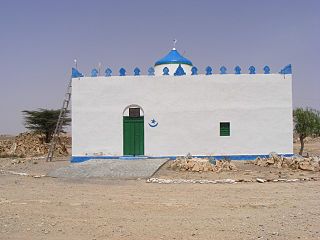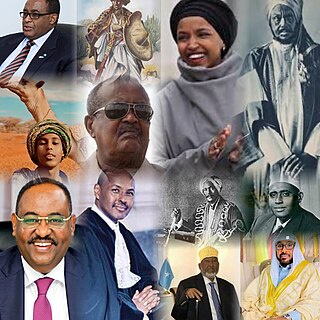Somalia, officially the Federal Republic of Somalia and formerly known as the Somali Democratic Republic, is a country located in the Horn of Africa. The country was an important centre for commerce with the rest of the ancient world, and according to most scholars, it is among the most probable locations of the fabled ancient Land of Punt. During the Middle Ages, several powerful Somali states and port towns dominated the regional trade, the Mogadishu Sultanate and Ajuran Sultanate both centered around the port town Mogadishu, but also the port towns of Barawe and Merca.

The Majeerteen is a prominent Somali sub-clan of the Harti, which falls under the Darod clan. Traditionally, they inhabit extensive territories in the Bari, Nugaal, and Mudug regions of Somalia, spanning from Bosaso to Garacad, mainly in Puntland state. Additionally, Majeerteen populations are present in southern towns such as Kismayo.
{{Infobox royalty | name = Mohamoud Ali Shire
محمود علي شري | image = Sultan Mohamoud Ali Shire 2.jpg | caption = Mohamoud Ali Shire in 1905 | succession = Sultan of Warsengali | reign = Late 19th century – January 1920 | predecessor = Ali Shire | birth_date = | birth_place = Las Khorey, Warsengali Sultanate | death_date = 1960 | death_place = Badhan, Sanaag, Somalia |Title = [[Sultan of Darood, Conqueror, | dynasty = | religion = Islam }} Mohamoud Ali ShireMBE was a Somali Sultan of the Warsengali Sultanate. He bore the title Sultan of the Warsangali. He was centered at Las Khorey.

The Isaaq is a major Somali clan family. It is one of the largest Somali clan families in the Horn of Africa, with a large and densely populated traditional territory.
The Warsangali is a major Somali sub clan, part of the Harti clan which itself belongs to one of the largest Somali tribe-families - the Darod. In the Somali language, the name Warsangali means "bringer of good news." The Warsangeli primarily inhabit the Sanaag.

The Hawiye is the largest Somali clan family. Members of this clan traditionally inhabit central and southern Somalia, Somaliland, Djibouti, Ethiopia and Kenya. They are also the majority in the capital city, Mogadishu.

The Darod is a Somali clan. The forefather of this clan was Sheikh Abdirahman bin Isma'il al-Jabarti, more commonly known as Darod. The clan primarily settles the apex of the Horn of Africa and its peripheries, the Somali hinterlands adjacent to Oromia (Ogaden), and both sides of the Kenya–Somalia border. The Darod clan is the largest Somali clan family in the Horn of Africa.
Hobyo, is an ancient port city in Galmudug state in the north-central Mudug region of Somalia.
The Dir is one of the largest and most prominent Somali clans in the Horn of Africa. They are also considered to be the oldest Somali stock to have inhabited the region. Its members inhabit Djibouti, Somalia, Ethiopia, and northeastern Kenya.

The Marehan is a Somali clan, which is part of one of the largest Somali clan families, the Darod.

The Sultanate of Hobyo, also known as the Sultanate of Obbia, was a 19th-century Somali Sultanate in present-day northeastern and central Somalia and eastern Ethiopia. It was established in 1878 by Yusuf Ali Kenadid.
The Habr Awal, also contemporarily known as the Subeer Awal, and alternately romanized as the Zubeyr Awal is a major Northern Somali clan of the wider Isaaq clan family, and is further divided into eight sub-clans of whom the two largest and most prominent are the Issa Musa and Sa'ad Musa sub-clans. Its members form a part of the Habar Magadle confederation.

The Somaliland Campaign, also called the Anglo-Somali War or the Dervish War, was a series of military expeditions that took place between 1900 and 1920 in modern-day Somalia. The British were assisted in their offensives by the Ethiopian Empire and the Kingdom of Italy.

Osman Mahmoud is a Somali sub-clan and is one of the largest sub-clans within the major Majeerteen Harti confederation of Darod. The sub-clan is most renowned for its rich history within Somalia, That of which include sultanates such as the Majeerteen Sultanate and Hobyo Sultanate.

The Bimaal or Bimal, is a sub-clan of the major Dir clan family. This clan is widely known for leading a resistance against the colonials in southern Somalia for decades which can be compared to the war of the Sayyid in Somaliland. The Biimaal mainly lives in southern Somalia, the Somali region of Ethiopia, which their Gaadsen sub-clan mainly inhabits and in the NEP region of Kenya.

The Majeerteen Sultanate, or Majerteen Kingdom also known as Majeerteenia and Migiurtinia, was a Somali kingdom centered in the Horn of Africa. Ruled by Boqor Osman Mahamuud during its golden age, the sultanate controlled the areas which are now called Puntland. The earliest mention of the kingdom is the 16th century. The polity had all of the organs of an integrated modern state and maintained a robust trading network. It also entered into treaties with foreign powers and exerted strong centralized authority on the domestic front.

Osman Mahamuud, also known as Uthman III ibn Mahmud, was a Somali king. He led the Majeerteen Sultanate during the 19th century.
The Gurgura, Gorgorah or Gurgure is a northern Somali clan, a sub-division of the Dir clan family.
The Makayl-Dheere also known as Makaahiil-Dheere (Makayldheere), is a northern Somali clan, a sub-division of the Makahiil sub-clan of the Gadabuursi Dir clan family.

The Isaaq Sultanate was a Somali kingdom that ruled parts of the Horn of Africa during the 18th and 19th centuries. It spanned the territories of the Isaaq clan in modern-day Somaliland and Ethiopia. The sultanate was governed by the Rer Guled branch of the Garhajis clan and is the pre-colonial predecessor to the modern Republic of Somaliland.






















